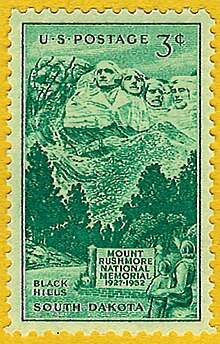
Back قائمة النصب التذكارية الوطنية في الولايات المتحدة Arabic Národní památníky ve Spojených státech amerických Czech Anexo:Monumentos conmemorativos nacionales de los Estados Unidos Spanish Liste des mémoriaux nationaux des États-Unis French Lista de memoriais nacionais dos Estados Unidos Portuguese 美國國家紀念碑 Chinese

National memorial is a designation in the United States for an officially recognized area that memorializes a historic person or event.[1] As of September 2020[update] the National Park Service (NPS), an agency of the Department of the Interior, owns and administers thirty-one memorials as official units and provides assistance for five more, known as affiliated areas, that are operated by other organizations.[2] Congress has also designated twenty-two additional independently operated sites as national memorials. Another five memorials have been authorized and are in the planning stage. Memorials need not be located on a site directly related to the subject,[3] and many, such as the Lincoln Memorial, do not have the word "national" in their titles. There is a degree of overlap in development of some areas designated as memorials, monuments, and historic sites, and their characterization is not always consistent with their names, such as whether the site is closely associated with whom it memorializes.[4]
The earliest and perhaps most recognizable is the uniquely designated Washington Monument, which was completed in 1884 and transferred to the NPS in 1933. The most recently established is the Dwight D. Eisenhower Memorial, dedicated in 2020. The Pearl Harbor National Memorial was created out of the World War II Valor in the Pacific National Monument in 2019 and was previously just the USS Arizona Memorial. The NPS national memorials are in 15 states and the District of Columbia. Washington, D.C., has the most, twelve, followed by Pennsylvania and New York, each with three. The affiliated areas are in four states (two additional beyond those with NPS memorials) and the Northern Mariana Islands, while the other sites are in nine states (five additional), the District of Columbia, and Midway Atoll. Creation of new memorials in Washington, D.C. is governed by the Commemorative Works Act, while outside the District there are no systematic regulations.[5]
Among the NPS national memorials and affiliated areas, ten celebrate US presidents, eleven recognize other historic figures, six commemorate wars, five memorialize disasters, and five represent early exploration. Eleven of the twenty-two non-NPS memorials commemorate wars or veterans, another ten represent groups of people who died for related reasons, and one relates to Native American history. Several major war memorials are located on or near the National Mall, contributing to the national identity.[6][7] The historic areas within the National Park System are automatically listed on the National Register of Historic Places.[8]
"National Memorial" is omitted below in the names of sites that include it; others may separate the two words or just use "Memorial", and there is also one international memorial included. Private and other organizations may use the name "national memorial" (such as George Washington Masonic National Memorial and National Memorial for Peace and Justice) but they are not officially designated by the federal government, and are not listed here, as they are not created pursuant to the statutory scheme.[9]
- ^ "Designations of National Park System Units". National Park Service. Retrieved May 4, 2019.
- ^ "National Park System" (PDF). National Park Service. January 13, 2017.
- ^ "What's In a Name? Discover National Park System Designations". National Park Service. Retrieved March 27, 2019.
- ^ Mackintosh, Barry (2005). The National Parks: Shaping the System. U.S. Department of the Interior. pp. 32–33. ISBN 978-0-912627-73-1.
- ^ "Memorials and Commemorative Works Outside Washington, DC: Background, Federal Role, and Options for Congress" (PDF). Congressional Research Service. May 29, 2019. Retrieved March 22, 2021.
- ^ Montgomery, David (July 31, 2018). "A wave of war memorials is coming to D.C. Are we all at peace with that?". Washington Post. Retrieved April 16, 2019.
- ^ Doss, Erika (September 7, 2012). Memorial Mania: Public Feeling in America. University of Chicago Press. ISBN 978-0-226-15939-3.
- ^ National Historic Preservation Act of 1966, Public Law 102–575, National Register of Historic Places. Retrieved May 13, 2019
- ^ "54 U.S. Code § 309101 – Sites and structures that commemorate former Presidents". LII / Legal Information Institute. Retrieved April 16, 2019.
© MMXXIII Rich X Search. We shall prevail. All rights reserved. Rich X Search